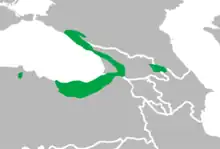| Caucasian parsley frog | |
|---|---|
 | |
| Scientific classification | |
| Domain: | Eukaryota |
| Kingdom: | Animalia |
| Phylum: | Chordata |
| Class: | Amphibia |
| Order: | Anura |
| Family: | Pelodytidae |
| Genus: | Pelodytes |
| Species: | P. caucasicus |
| Binomial name | |
| Pelodytes caucasicus Boulenger, 1896 | |
 | |
The Caucasian parsley frog (Pelodytes caucasicus) is a species of frog in the family Pelodytidae. It is found in Azerbaijan, Georgia, Russia, Turkey, and possibly Armenia. Its natural habitats are temperate forests, temperate shrubland, rivers, intermittent rivers, freshwater marshes, intermittent freshwater marshes, and freshwater springs. It is threatened by habitat loss.
The natural history of this frog is poorly understood, with most of it coming from behaviors and habits observed during the spring when they gather in vernal pools to breed.
One study has found that during the summer, the frogs take shelter inside remote limestone caves, and showed a strong preference for caves which harbored colonies of bats.[2] This is most likely because they could eat the insects that proliferated in the bat's guano.
References
- ↑ Ugur Kaya, Boris Tuniyev, Sako Tuniyev, Sergius Kuzmin, David Tarkhnishvili, Boris Tuniyev, Theodore Papenfuss, Max Sparreboom, Ismail Ugurtas, Steven Anderson, Güven Eken, Tuba Kiliç, Engin Gem (2009). "Pelodytes caucasicus". IUCN Red List of Threatened Species. 2009: e.T39422A10236383. doi:10.2305/IUCN.UK.2009.RLTS.T39422A10236383.en. Retrieved 15 November 2021.
{{cite journal}}: CS1 maint: multiple names: authors list (link) - ↑ Dinets, Vladimir (October 2015). "Trogloxeny in the Caucasian parsley frog (Pelodytes caucasicus)". Herpetological Bulletin.
- Dinets, V. Trogloxeny in the Caucasian parsley frog (Pelodytes caucasicus). Herpetological Bulletin, October 2015
- Tarkhnishvili, D., Gokhelashvili, R. 1999. The Amphibians of the Caucasus. Pensoft Publishers.
- AT Chubinishvili, RK Gokhelashvili, DN Tarkhnishvili. 1995. Population ecology of the caucasian parsley frog (Pelodytes caucasicus Boulenger) in the Borjomi Canyon. Russian J. Herpetol. 2: 79-86.
